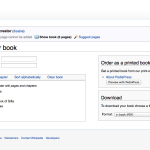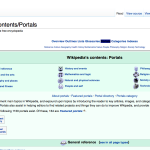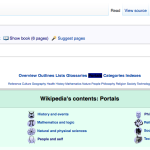It is Christmas Day and as my wife and I don’t have children, we have oodles of time to do things like write blog posts. I just finished grading my finals for the semester, coding a few transcripts for my PhD study, writing up a bit of the data, and now I turn my attention to an idea that has been clanging around my brain since I was about halfway through the semester. That time when I began to realize that all my lofty pedagogical ambitions were settling into realistic, if slightly less exotic, classroom realities. As teachers, we tinker and iterate so here I am at the drawing board looking for a way to maximize the learning experience for my students. So I turn my attention to Wikipedia.
I am not the first to try and use Wikipedia as a teaching tool, nor will I be the last. It has significant resistance in my community (as in generally in Korean academia) and for the same reasons we have always heard regarding its authority and validity. Some sources that attempt to turn the tide of resentment within academia towards Wikipedia as a teaching tool (especially Konieczny, bravely, in 2007) are useful for background, but it is really Hammond (2012) that I am borrowing piecemeal for my activity. But first the process.
- Konieczny, P. (2007). Wikis and Wikipedia as a teaching tool. International Journal of Instructional Technology and Distance Learning, 4(1), 15-34.
- Commeyras, M., Lang, L., & Evers, A. J. (2012). Writing for Wikipedia: Teaching: An Authentic Writing Experience. 순천향 인문과학논총, 31(1), 159-176.
- Konieczny, P. (2012). Wikis and Wikipedia as a teaching tool: Five years later. First Monday.
- Hammond, T. (2012, October). Historical thinking as Applied Epistemology: Developing historical thinking in social studies methods courses via critical inquiries of Wikipedia entries. In World Conference on E-Learning in Corporate, Government, Healthcare, and Higher Education (Vol. 2012, No. 1, pp. 1634-1643).
- Abellán-Nebot, J. V., Bruscas, G. M., Serrano, J., & Romero, F. (2013, July). Wikipedia as a Tool for Active Learning. Experience Gained within the Framework of the Wikifabricación Project. In Materials Science Forum (Vol. 759, pp. 73-82).
Step 1: Wikipedia as Textbook and Using the Book creator tool
You may or may not have noticed off to the left of Wikipedia pages, but there is a small Create a Book link. From there, click Start Book Creator and then you can add any page of value from Wikipedia to your book. Add any and all pages to your book, click Show Book, give it a title and export it. You can generate individual chapters, edit and arrange things as you will, etc. You can even have it printed. Download it as a PDF, ePub, or ODT and edit as needed. Insert media as needed as well. A rough and ready textbook.
I am inserting a sample here, one that I put together as I was writing this post: Korean History of the Silla Kingdom
Since this aspect of the exercise is teacher-driven, great care should be taken to ensure that the sequence of pages and information is logical and represents a discernible pattern for the students to follow. Concepts should scaffold and I generally try to provide a sequencing of expanding or narrowing (smaller to bigger concepts or vice versa). Great care should be taken to ensure that the necessary references and citations are present as well for the students to evaluate the sources as well, which is essentially the next step.
The teacher should take the textbook and then add reflective activities early and often. The textbook becomes the workbook in this way. After pertinent passages or difficult concepts, the teacher should insert reflective questions or comprehension checks. The students, ideally via their own blog, reflect on these questions as they come across them, say 2-3 per week (or more, depending on how demanding you want the exercise to be). The blog space also allows them to work with other modes in coordination with text; indeed that can be part of the requirements. I often require my students to choose representative media to support their assertions in their writing.
So the teacher inserts these reflective prompts through the textbook, distributes it and students work through the text and their reflections at a relatively flexible pace throughout the semester. Classroom activities are positioned as discussion activities where they can collaborate and ask questions to further expand their comprehension. In fact, I like to have groups set up specifically for this purpose amongst the students (4-5 students per group) where a student is responsible for preparing the agenda and the discussion for their group and reports to their blog later about the discussion and the negotiated points of understanding.
Step 2: Evaluate Pages and Posts; Map missing concepts
So the book is generated and distributed and there is no cost and the information is open access. All is well and good. Yet there is a legitimate question here about the authority and validity of what is being presented. Rather than bemoan that darkness/excuse, I would rather turn it into a pedagogical advantage. Turn the questions over authority into the object of investigation. This is what Hammonds (2012) does in regards to historical epistemology and the use of Wikipedia; he simply turns it into an exercise in critical thinking.
Assign the groups or individual students in the group one chapter from the generated textbook and have them critique the authority of the sources and the validity of their information. This can be a semester-long project if need be as it does require some initial foundation on source evaluation and information literacy in general. Some good sources exist and some academic literature exists towards this effect:
- Sormunen, E., Lehtiö, L., & Heinström, J. (2013, May). Writing for Wikipedia as a learning task in the school’s information literacy instruction. In ISSOME 2011 Conference (Abo/Turku, Finland), at https://www12. uta. fi/blogs/know-id/files/2011/08/ISSOME-abstract-Writing-for-Wikipedia-as-a-learning-task-in-the-school. pdf, accessed (Vol. 24).
- Lau, J., Gárate, A., & Osuna, C. (2013). Walking from Concepts to Facts: A Holistic Information Literacy Approach Experience at the University Level. InWorldwide Commonalities and Challenges in Information Literacy Research and Practice (pp. 302-308). Springer International Publishing.
- Schreiber, T. (2013). Information Literacy, Mobile Technologies and Study Practices. In Worldwide Commonalities and Challenges in Information Literacy Research and Practice (pp. 317-323). Springer International Publishing.
OK, the last one I threw in there strictly because it was about mobile technology, but you get the picture. So you begin with lessons on what constitutes a credible source in regards to your specific discipline (they vary), identify the attributes of that source, and then compare these attributes and these evaluative techniques towards authentic works. What source materials was Darwin using for the Origin of the Species? What was Marx using for Das Kapital? etc. etc.
Whatever you decide to do, by all means establish a rubric for evaluation, but make it flexible enough to evolve as the students’ understanding of their own capacity for disciplinary thought changes as well. So the project at this stage is a group critique of a chapter according to the following:
- Authority/Credibility of the sources being presented
- Validity of the information being presented
- Comprehensiveness of what is being presented
The last one is of particular interest to me as it is a good chance to use some applications for concepts maps. Have the students map the existing concepts of the chapter, identify what is missing (marked as different colors on the map) in terms of a more comprehensive chapter, research these additions, and identify sources that might serve to explain these additions.
I suggest using a tool that is both a>free and b>allows for exporting of the finished product. Coggle fits the bill at the current moment but these applications appear and disappear with great speed. Just make sure that the finished map can be exported in an accessible format. Coggle allows for exporting in PDF and PNG, both formats that can be inserted into students’ blogs (which is where the report analyzing the chapter should be posted). So this whole activity is one big exercise in critical thinking. Identifying what is there, what is missing, and what needs to be included to represent the whole. No small feat, but a necessary skill.
Step 3: Assign Portals to Students
Another activity (for classes with less subject specific requirements, like many of my writing classes), one can use the Wikipedia portals to great effect. From the homepage, click All Portals (easy to miss). Simply go a portal of interest to your class, identify a portal for sub-concept, for example this one on Confucianism, and let the student or the group identify a concept, person, event, etc, of some interest within that portal to research and reflect on over the course of the semester. Each student can generate a text on that particular concept using the methods described above, present that book and a short essay on the significance of the information found in the book. Each student or group is responsible for generating their own work on their own particular chosen topic (all within one portal to ensure that there is at least some connective tissue to these explorations).
Once these are all generated and posted to their blogs, and assuming the teacher has done a good job and made a news feed available for the class of all the blogs and social media discussion (via RSS), then each student is responsible for choosing a book from another student and critiquing the connections between that report and the one they generated. This is an exercise in application. Students are forced to think laterally about how this information and that information are related, and how they both speak to the larger concept presented in the overall portal. This type of cross-group activity helps break up the monotony of teacher-student chains of communication as well.
Step 4: Students generate textbooks as assignments
In an endless semester, I would try this one as well, which is basically giving each group the responsibility of generating their own textbook for novice learners that might follow them. Each student is forced to reflect on what represents the core concepts of the subject, the terms necessary to speak accurately about that subject, the ideas, thinkers, events, dates, etc. that provide the connective tissue of meaningful activity and understanding. They are forced to reflect, evaluate, generate, edit, refine, and iterate. They are also required to insert their own reflective prompts into the text itself.
If pressed for time, this can be modified to have students or groups generate individual chapters after negotiating an overall outline of the book with the whole class. The end result is a generated ebook and a reflective statement on why and how it was generated. I might suggest this is an ideal activity for the future teachers of the world.
So there you have it. Lots to do with Wikipedia and I am incorporating a few of these activities into my own teaching next semester. Rather than turn from it in fear and indignation, we as academics have a duty to observe and analyze it, or at least try to figure out where it gets all this energy, its power. The lack of control we have over it makes it an ideal real-world application of critical thinking, disciplinary epistemology, and even just an exercise in concept mapping. And it is free and open to everyone.









Going through old teaching posts: Teaching/Wikipedia: generating ebooks, evaluation, concept maps. https://t.co/PhANdhycMq #elearning
Book creator @Wikipedia good way to create zero-cost textbooks https://t.co/9xyaBilir9 I wrote few years back on it… https://t.co/62dylOx013